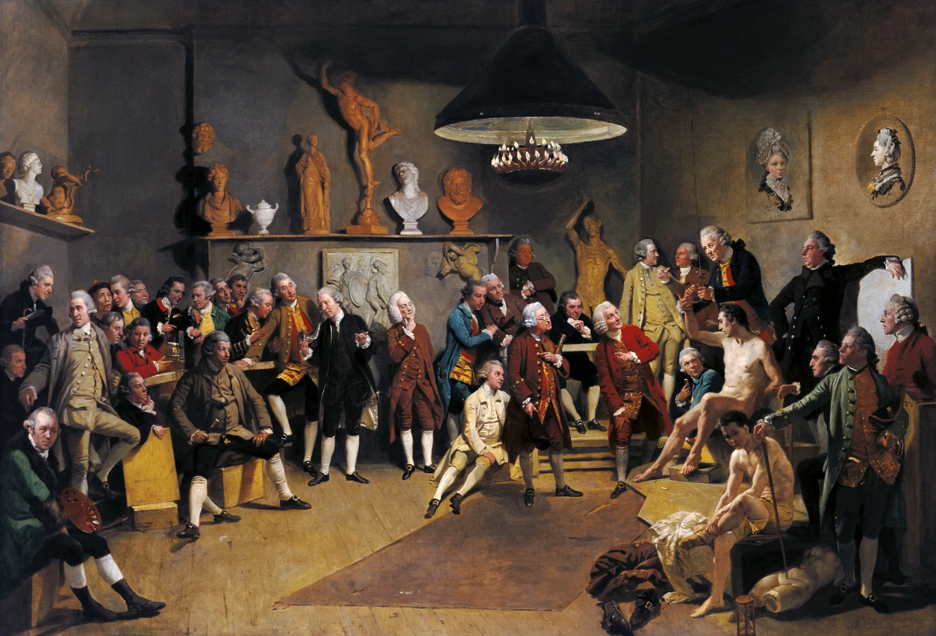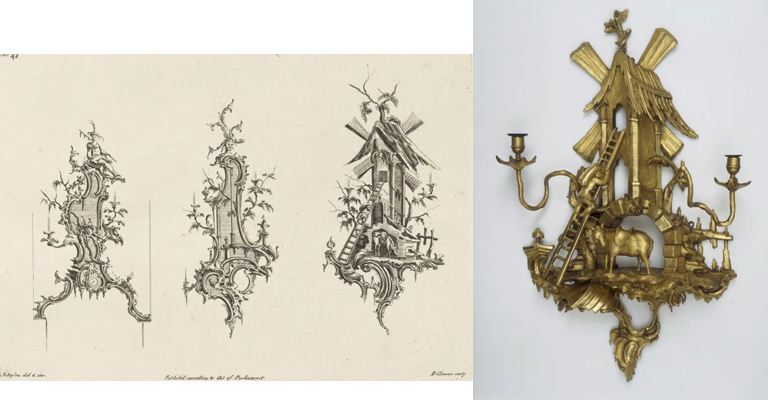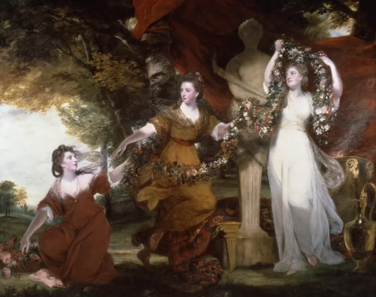Lecture 9: Manufacturing Art in 18th-Century Britain
1/12
There's no tags or description
Looks like no tags are added yet.
Name | Mastery | Learn | Test | Matching | Spaced |
|---|
No study sessions yet.
13 Terms
Key Ideas (2)
Artistic hierarchies tell us about society in general
Art has always been literally manufactured (made by human hands)
Ultimately, the degree to which this is admitted/rejected tells us a lot about what a society values
Ideas about class, status, value, freedom
The borderlines of what is called art have always been porous
While many have attempted to break them down, even more have been anxious to reinforce them
Because there is so much at stake
Problems in studying Manufactured Art (3)
Assumptions about the nature of ‘fine art’ vs. ‘decorative art’
Fine art: made in a studio, by a single (known) person, as a form of self-expression (NOT made to primarily be functional)
Decorative art: made in a factory, by several people/a team, to be used for a specific function
As a result, the decorative arts are rarely studied in the discipline of Art History
BUT is there actually a justifiable distinction between Art & Craft/Manufacturing?
Existing ideas about ‘fine art’ are actually entangled w/ other forms of making
Historical context (4)
18th-century Britain
Global empire was expanding
Wealth was rising
Led to:
Highly commercialised, consumerist society
Beginnings of industrialisation
Intense, nationalistic competition for trade
Health of the nation seen to depend on exports
Standard of art & manufacturing in Britain was seen as crucial for its performance on the international stage (offered both financial & cultural power)
E.g. vs. France, which was believed to have had domination in terms of taste = had financial consequences
Belief that the key to restoring British supremacy was through the study of drawing & design
Would not only increase the standard of British products
But also improve the taste of British consumers
Hierarchical division was emerging between fine art & manufacturing (both closer & further away from each other than they had ever been)
Ideal: development of categorisations of Art (antiquity to 18th century)
Art-Craft divide
Classical Greco-Roman antiquity: painting & sculpture EXCLUDED from liberal arts
Liberal arts: arithmetic, geometry, rhetoric, etc.
Special category of skill/knowledge that is more intellectual & elevated than the rest
Associated w/ freedom:
(1) Contributed to the freedom of the mind
(2) Considered necessary for a free citizen to participate in civic life (politics)
I.e. only for men (NOT women & slaves)
Middle ages: painting & sculpture seen as mechanical arts
Follows physical/manual (mechanical) principles
Not much differentiation within the category of art itself (e.g. architect = builder = painter)
Renaissance: artists tried to raise their status by claiming that painting, sculpture, & architecture were liberal arts
Required BOTH intellectual & manual skills
An good artist needs a broad program of study
E.g. anatomy, philosophy, history
By the 18th century: painting, sculpture, & architecture were often referred to as fine arts
BUT still were NOT highly regarded in general
Some elevation of status, but NOT a straightforward process
Artists struggled to be seen as liberal artists
Due to issues of class ⭐
Most artists came from families of artisans, NOT from the gentry/nobility
Nonetheless, there was an increasing desire to achieve this status
Reality: blurred lines between Art & Manufacturing
Named example
Historical context
Description
Interpretation
Drawing as a link between the fine & mechanical arts
Named example: Thomas Johnson
Historical context
Was a furniture carver in London
Working in Rococo style
Asymmetric profusion of decorative motifs
Eclectic mix of influences
Sometimes to an excessive degree
Description
Published his drawings
Emphasised his own authorship on the printing plate by signing it
Drawings were then used by himself & other craftsmen to make actual objects in carved & gilded wood
E.g. girandoles (sconces attached to the wall that can have candles put in them)
Very decorative = can’t strictly be considered purely functional
Were often simplified from the drawings, which depicted designs that were far too complicated/difficult to execute
Interpretation
Craftsman presenting himself as a draftsman/artist
Using the medium of engraving to advertise his skill & show how inventive his mind is ⭐
Asserting that his work is NOT just manual craft, BUT assumes the status of ‘art’
Attempts to distinguish between Art & Manufacturing
Named example
Historical context
Interpretation (3)
Named example: The Royal Academy of Arts
Historical context
Founded in 1768
Key founding member & 1st President: Joshua Reynolds
Painter
‘The value & rank of every art is in proportion to the mental labour employed in it, or the mental pleasure produced by it. As this principle is observed or neglected, our profession becomes either a liberal art, or a mechanical trade.’ ⭐
Privileged history painting as the most important form of art
Purpose: to improve the standards of British taste & design (Nationalistic project)
Believed that by doing so with regards to the fine arts would have a trickle down effect on the rest of the arts
Focus on the fine arts
Painting, sculpture & architecture only
Crafts & amateur art were excluded
Anything fundamentally reproductive
E.g. needlework, copies of artworks
Underwritten by the King (‘Royal’)
= testament to the elevated status of artists
Academic structure:
History painting was privileged
‘Elevated’ subject matter (e.g. mythology, religion, history)
Elevated style (idealised, classical style, ‘the grand manner’)
Was considered a liberal art
Students studying history painting in the RAOA had to study a range of other subjects e.g. philosophy, history, classics
Pathway:
Studying & copying existing classical sculptures
Then studied & drew from nude models (life drawing)
Ultimate goal: to create art that could instruct, inspire, and elevate the minds of the citizens who saw them
Far from art as a mere skill/trade
Interpretation
Assumption that fine arts are fundamentally superior to the rest
Conclusive separation of education pathways
E.g. no more belief that an education in drawing could enable one to both make art and design furniture
Idea of art as:
Founded on the tradition of antiquity, the old masters & the human body
Original, unique
Intellectually engaged & engaging
Hierarchy even within the fine art category
History painting → portraiture → landscape → everyday scenes → still life
Existed since the Renaissance BUT newly embraced by the RAOA
Due to beliefs about how much intellectual engagement was required to produce & appreciate each kind of painting
E.g. whether the painting was a result of the artist’s ideal conceptions or just a copy of nature
Reality: bread and butter concerns (2)
There wasn’t much of a market for history painting in Britain
Grand, monumental, expensive
Hard for such artists to make a living
= Reynolds’s bread & butter was portraiture instead, although he strongly pushed for history painting in his teaching
Tried to manage this conundrum by incorporating elements of history painting into his portraits
E.g. Three Ladies Adorning a Term of Hymen (1773)
Artists like Reynolds still worked for profit
Employed other artists & assistants to help complete his paintings
Had been common practice for hundreds of years
Typically, in 18th century Britain:
Patrons would go to big name artist
Artist would devise composition & execute portrait face
Fabrics/clothes would be executed by a specialist drapery painter in another studio
Studio assistants might execute background
Subverts Romantic notions of the individual artist working alone in his studio
Created in the late 18th-early 19th centuries
To shore up the reputation of artists & protect them from associations with manufacturing, commerce, & manual labour ⭐
Named example: Josiah Wedgwood
Historical context
The most successful ceramics manufacturer in Britain (and even internationally)
Not only a driver of taste in the nation, but also spearheaded important changes in industrial production
Set up a factory producing ceramics in Staffordshire in 1769
The year after the RAOA was founded
Made useful things like plates, teapots, teacups
For a broad middle-class market
BUT also made more artistic, ornamental objects
To be aesthetically pleasing and attest to their owner’s good taste
Believed that manufacturing & art should be united, and seen as having 1 single point of origin
Problems
Customers were wary of paying high prices for objects made in ceramics
Even if cost of product development & manufacturing them was genuinely quite high
Ceramics was associated w/ tableware
Even lower category vs. silverware
Busts & medallions were made using molds
Prejudice against reproductions = not highly valued
Solutions
Wedgwood introduced many innovations in his factory that were historically important
E.g. effective use of production lines
E.g. quality control → so he could use catalogues to sell his works
Talked about ‘making machines of men’
Wedgwood launched a campaign to show that ceramics could be more than a low mechanical art and that consumers, in fact, should expect to pay higher prices for these objects
(1) Employed artists from the RAOA to raise the quality of the molds he used
E.g. John Flaxman: commissioned to make low relief models in the style of classical subjects, often directly imitating classical vase paintings → could then be applied to any no. of objects
(2) Ensured his in-house factory modelers achieved a high level of finish on each ornamental piece after it came out of its mold
Adding of details
E.g. undercut areas only emphasised after an object was de-molded
= gave the impression of an individual, unique work, rather than merely a cast
(3) HOWEVER, Wedgwood never used the names of commissioned artists/mentioned academic associations in his catalogues/promotional material
Conversely, stamped his own name onto his products ⭐
As a sort of signature/certificate of authenticity that raised their prestige
Discouraged the individual modelers/makers from putting their mark on the things they made in the factory
Beginning to apply the principles of artistic authorship to manufacturing?
Artwork would be priced based on the prestige of the great artist’s name alone
In fact, would devalue the artwork if other names were mentioned
Consequences & Later Developments
Progress in the merging of the fine & mechanical arts:
Arts & Crafts movement in the 19th century
Advocated for handcrafted items and a return to traditional craftsmanship
A reaction against:
(1) The commodification of art & the industrialisation of craftsmanship
(2) The RAOA’s attempt to separate the fine & decorative arts
Rise of readymades in art
Claimed artistic status for mass-produced objects
E.g. Marcel Duchamp’s Fountain: urinal made out of industrially-produced ceramic
Explains why it was so shocking
Andy Warhol
Played w/ the contentious divide between art & manufacturing
Studio was called ‘The Factory’
Spoke of wanting to make himself work like a machine
Silkscreen printing
Itself a reproductive technology
Produced en masse by his studio assistants, not necessarily touched by his hands
Artists like Jeff Koons/Damien Hirst
Artistic production is mostly outsourced a team working in their factory-like studio
Produced on enormous scales, for enormous profits
Although Wedgwood made much unprecedented progress, attitudes about the distinctions between fine & mechanical arts ultimately persisted:
Walter Benjamin’s The Work of Art in the Age of Mechanical Reproduction (1935)
Was writing about photography
A different kind of mechanical reproduction
But equally felt to threaten the very basis of art
Claimed that art had lost its ‘aura’
Special properties of an individual, unique, original work of art
This idea emerged in the 18th century
When artists were most anxious to distinguish their work from that of mere manufacturers
BUT Benjamin sees this as a potentially liberating force
Goethe’s essay on Art & Handicraft (1797)
By then, Wedgwood’s classically-inspired objects had become famous across Europe
Goethe was horrified at both his commercial success & social ascent
‘The original/true artist makes original, not reproductive works and bestows upon his material an eternal, inward value’ vs the mechanical artist just repeats himself, ‘his thousandth work is like his first’
Such developments ‘[bid] fair to be the utter downfall of art’

The Academicians of the Royal Academy (1771-72), Johan Joseph Zoffany
Historical context
Group portrait of the founding academicians of the RAOA
Analysis
Men in conversation/debate/study of the live model
The most highly-prized Renaissance & classical sculptures in the background
Central figures:
Joshua Reynolds (1st President of the RAOA)
William Hunter (anatomist)
Pictured in conversation - compositional reference to Raphael’s School of Athens
Plato pointing up @ the world of ideas = Reynolds
Aristotle pointing down @ the world of particulars = Hunter
Only 2 women present in the form of portraits on the wall
2 founding members of the RAOA
Drawing from nude models considered immodest for women (even in an imagined scene like this)
Vs. their abundant presence at the Society for the Encouragement of Arts, Manufactures, and Commerce
Interpretation
Proclaims the principles of the RAOA
Foundation of art on the study of antiquity, old masters, & the human body
Witty & elevated references to famous works of art
= the ideal kind of artwork that the RAOA would promote

Thomas Johnson’s Girandoles (1750s)
Historical context
Thomas Johnson
Was a furniture carver in London
Working in Rococo style
Asymmetric profusion of decorative motifs
Eclectic mix of influences
Sometimes to an excessive degree
Published his drawings
Drawings were then used by himself & other craftsmen to make actual objects in carved & gilded wood
E.g. girandoles (sconces attached to the wall that can have candles put in them)
Were often simplified from the drawings, which depicted designs that were far too complicated/difficult to execute
Analysis
Emphasised his own authorship on the printing plate by signing it
Very decorative = can’t strictly be considered purely functional
Interpretation
Craftsman presenting himself as a draftsman/artist
Using the medium of engraving to advertise his skill & show how inventive his mind is ⭐
Asserting that his work is not just manual craft, but assumes the status of ‘art’

Three Ladies Adorning a Term of Hymen (1773), Sir Joshua Reynolds
Historical context
There wasn’t much of a market for history painting in Britain
Grand, monumental, expensive
Hard for such artists to make a living
= Reynolds’s bread & butter was portraiture instead, although he strongly pushed for history painting in his teaching
Tried to manage this conundrum by incorporating elements of history painting into his portraits
Analysis
3 sisters adorning a bust of Hymen (the God of marriage)
Interpretation
Reynolds creates a narrative, turning his human figures into characters enacting a story
Makes the patron feel intellectually superior for understanding the reference

Pegasus Vase (ca. 1786), Wedgwood factory, with reliefs by John Flaxman
Description
Pale blue jasper
White reliefs
Domed cover w/ figure of Pegasus on top, resting on a pale blue cloud
Other iconography: olive wreath on the neck of the vase, Medusa heads beneath handles (Greek myth)
Analysis
In-house modellers added a high level of finish after objects were removed from their moulds
Degree of detail was limited by moulding
BUT fine details were then hand-carved
= gave the impression of a unique work of sculpture
Commissioned John Flaxman to make low-relief models in the style of classical subjects
Sculptor who had trained at the Royal Academy
Designs often directly imitated classical vase paintings
In this case: Main scene was The Apotheosis of Homer
From an engraving of a Greek vase of the 4th century BCE
BUT Wedgwood never credited Flaxman in his products/promotional material
+ discouraged individual modellers from putting their mark on the products they made at his factory
Instead, stamped his own name at the bottom of the vase
= certificate of authenticity that raised their prestige
Interpretation
Wedgwood created & capitalised on an entirely new middle-class market
Couldn’t afford a Grand Tour/real antiquities themselves
BUT were still enthusiastic to follow classical trends in fashion & decor
Wedgwood was beginning to apply the principles of artistic authorship to manufacturing
His products would command a price based on the prestige of Wedgwood’s name alone
Similar to how artists signed their artworks since the Renaissance (15th century)
Wedgwood actively trying to claim a higher status for his crafts as art
Through classicism & authorship
Despite traditional assumptions
E.g. ceramics were traditionally viewed as low-status: were a functional form of dishware, and weren’t made of a precious material (e.g. silverware)